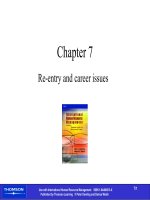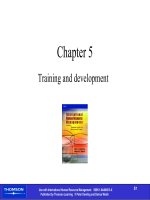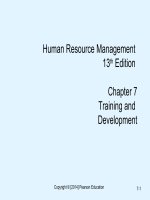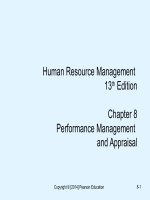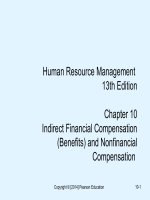Human resource management mondy 13th edition chapter 03
Bạn đang xem bản rút gọn của tài liệu. Xem và tải ngay bản đầy đủ của tài liệu tại đây (479.28 KB, 82 trang )
Human Resource
Management
13th Edition
Chapter 3
Workplace Diversity, Equal
Employment Opportunity, and
Affirmative Action
Copyright © [2014] Pearson Education
Learning Objectives
• Discuss lesbian, gay, bisexual, and transgender
employees as a protected class.
• Describe diversity and diversity management and
explain the various components of the diverse
workforce.
• Identify the major laws affecting equal employment
opportunity.
• Describe the recent trend against employee retaliation.
• Identify some of the major Supreme Court decisions
that have had an impact on equal employment
opportunity and affirmative action.
Copyright © [2014] Pearson Education
Learning Objectives (Cont.)
• Describe the Equal Employment Opportunity
Commission and explain the purpose of the Uniform
Guidelines on Employee Selection Procedures.
• Describe disparate treatment and adverse impact and
explain the Uniform Guidelines related to sexual
harassment, national origin, religion, and caregiver
(family responsibility) discrimination.
• Explain affirmative action as required by presidential
Executive Orders 11246 and 11375 and describe
affirmative action programs.
• Describe sexual harassment in the global environment.
Copyright © [2014] Pearson Education
HRM in Action: Lesbian, Gay, Bisexual, and
Transgender Employees as a Protected
Class?
•Increased focus in political and workforce
arena
•Public tends to support equal rights for
gay people — with exception of right to
marry
•Many companies have policies in support
of LGBT employees
Copyright © [2014] Pearson Education
3-4
Diversity
• Any perceived difference among
people
• More than equal employment and
affirmative action
• Creates workforces that mirror
populations and customers
Copyright © [2014] Pearson Education
Diversity Management
Ensuring that factors are in place to:
• Provide for and encourage the
continued development of a diverse
workforce
• Meld actual and perceived
differences among workers
Copyright © [2014] Pearson Education
Components of the Diverse
Workforce
• Single parents and
working mothers
• Women in business
• Mothers returning to
the workforce
• Dual-career families
• Workers of color
• Older workers
• People with
disabilities
• Immigrants
• Foreign workers
• Young persons, some
with limited education
or skills
• Baby Boomers, Gen
X, Gen Y, and Gen Z
Copyright © [2014] Pearson Education
Single Parents and Working Mothers
• Number is growing
– 50% of marriages end in divorce
– Widows and widowers who have children
• 72% of mothers with children under 18 are in
workforce
• Being a mother does not significantly change
young women's career ambitions
Copyright © [2014] Pearson Education
Women in Business
• Prominent rise in number of women in labor
force
• Entering labor force in high-paying,
professional jobs and women dominating
health-care sector
• Women make up majority of American
workforce
• Many opt out of corporate life
Copyright © [2014] Pearson Education
Mothers Returning to the
Workforce
• More new mothers are leaving the labor
force only to return later
• Some firms are trying to recruit them to
return to labor force
• Some employers have programs that help
their employees leave and later return
Copyright © [2014] Pearson Education
Dual-Career Families
• Both husband and wife have jobs and
family responsibilities
• Children often have both parents working
outside home
• Often turn down relocations
• Want more workplace flexibility
Copyright © [2014] Pearson Education
Workers of Color
• By 2016, 43% of new job applicants will be
people of color
• Often experience stereotyping
• Often encounter misunderstandings and
expectations
• Bicultural stress
• Culture of origin can lead to
misunderstandings in workplace
Copyright © [2014] Pearson Education
Older Workers
• Many Boomers deferred retirement
• United States faces rapid departure of
Boomers
• Many companies try to keep the over-55
worker
Copyright © [2014] Pearson Education
Persons with Disabilities
• Disabled workers do as well as
unimpaired workers in terms of:
– Productivity
– Attendance
– Average tenure
• Costs for accommodations differ very
little from those for general population
Copyright © [2014] Pearson Education
Immigrants
• Large numbers of immigrants have
settled in United States
• Require time to adapt
• Managers must work to understand
different cultures and languages
Copyright © [2014] Pearson Education
Foreign Workers
• The H-1B employment visa brings in
upwards of 115,000 skilled foreign workers
annually
• 85,000 are distributed to employers
through a lottery system
• Exact number of H-1B visa holders is
difficult to determine
Copyright © [2014] Pearson Education
Young Persons, Some with Limited
Education or Skills
• Lower labor force participation rate for
young people
• Recent recession was especially harsh
for 16-to-19-year-olds
• Often have poor work habits
• Can do many jobs well
• Jobs can be de-skilled
Copyright © [2014] Pearson Education
Baby Boomers
• Born just after World War II through the
mid-1960s
• Employers seek out boomers because
they bring a wealth of skills and
experience to the workplace
• Recognized as having a great work ethic
and a solid attendance record
Copyright © [2014] Pearson Education
Generation X
• 41 million American workers born between
the mid-1960s and late 1970s
• Possess lots of energy and promise
• Job instability and the breakdown of the
traditional employer-employee relationship
• Think more as free agents and expect to
build career security, not job security
Copyright © [2014] Pearson Education
Generation Y
• People born between the late 1970s
and late 1990s
• Promises to be the richest, smartest,
and savviest ever
• Strong sense of morality and civicmindedness
• Childhoods have been short-lived
Copyright © [2014] Pearson Education
Generation Z or Digital Natives
• Born between 1995 and 2009
• More worldly, high-tech and
confident
• Tend to have short attention spans
• Desire speed over accuracy
• Enjoy media that provides live
social interaction
Copyright © [2014] Pearson Education
Multigenerational Diversity
• Four generations are now in the workforce
• Each has different defining characteristics
and nicknames
• Managers need to be aware of and skilled
in dealing with the different generations
Copyright © [2014] Pearson Education
Equal Employment Opportunity:
An Overview
• EEO modified since passage of:
– Equal Pay Act of 1963
– Civil Rights Act of 1964
– Age Discrimination in Employment Act of 1967
• Other congressional legislation
• Major Supreme Court decisions
• Executive orders signed into law
Copyright © [2014] Pearson Education
Laws Affecting Equal
Employment Opportunity
Copyright © [2014] Pearson Education
Civil Rights Act of 1866
• Oldest federal legislation affecting
staffing
• Based on Thirteenth Amendment
• No statute of limitations
• Employment is a contractual
arrangement
• Extended to cover private parties in
1968
Copyright © [2014] Pearson Education


